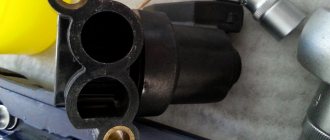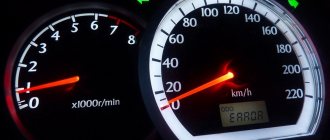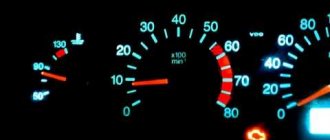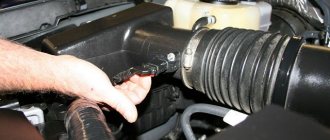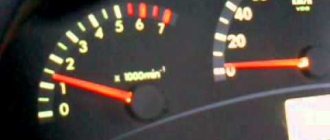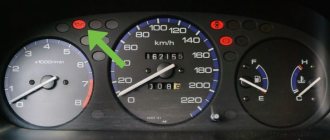It is very important that the engine operates correctly in any mode, including idling. However, many car owners are faced with a problem: when they release the gas, the engine speed does not drop. As soon as such a defect is discovered, it is necessary to immediately find out the cause and eliminate the malfunction for the smooth operation of the car. Also, the engine may slow down for a long time, which also does not contribute to proper operation.
Typically, upon reaching operating temperature, the speed should drop to its normal level. The manufacturer indicates the indicators for each specific vehicle model in the operating manual. They may vary slightly depending on the mileage and general condition of the car, but usually stay within the range of 650-1000 rpm.
In some cases, the speed drops very slowly or even stays at the same level of 1500-2000 revolutions. In this mode, not only does fuel consumption increase, which affects the driver’s finances, but it also contributes to engine wear.
The cause of the idle failure must be diagnosed by qualified technicians. However, you can also understand on your own why the engine speed does not drop.
The origins of unstable engine operation at XX
How will the picture develop if the control unit does not receive data on the quantity and volume of air consumed?
So, for example, the reaction of the throttle sensor will be as follows - the speed will initially increase, but then the fuel mixture will begin to become leaner, as a result of which low speed will be established on a hot engine. There is only one reason for this - the amount of air consumed by the engine has decreased. However, the opposite happens - the fuel mixture becomes richer, and the engine begins to gain speed again. Such cycles can alternate endlessly; these are floating revolutions. The problem of low idle speed on a warm engine in winter is especially pressing.
On some cars, events may develop differently - the speed increases, for example, to 2000 rpm, but remains there. The reason is that the injector injects increased amounts of fuel. The amount of air does not increase, otherwise the engine would be able to increase the speed to 3 thousand, however, then it would still start to stall.
How to find the cause of the problem
If the speed of the VAZ 2114 drops, you need to comprehensively diagnose the functioning of the injection system on your car, which can be done in your garage if you have a little experience and appropriate instructions. In this case, those “fourteeners” that were equipped from the factory with a dashboard from the German manufacturer VDO have an important advantage, since it, in comparison with the analogue from Schetmash, is equipped with a self-diagnosis mode.
To carry out this procedure, you will need to perform a few simple steps:
- After turning off the engine, you need to keep the odometer button pressed for three to five seconds;
- Having turned the engine ignition to the first position, the button must be released;
- arrows should appear on the display, which is a signal of normal operation, then the button must be pressed the first time (displaying the firmware version) and the second time - after this probable errors in the ECU will be shown;
- To reset the error message, you will need to hold the button until a zero appears on the display.
After reading the manual, you can find out what errors shown on the screen may be associated with the fact that the speed constantly drops when the gas is released on the VAZ 2114.
So, it could be one of the following situations:
- code 1 – controller error;
- code 14/15 – coolant sensor error;
- code 22/23 – throttle position sensor error;
- code 33/34 – mass air flow sensor error;
- code 42 – faulty ignition;
- code 44 – fuel mixture is lean or too rich.
The owner of a VAZ 2114 should remember a specific feature of the self-diagnosis mode on his car: if there are several errors, the computer sums their codes arithmetically, which can be misleading. This can be indicated by a logical discrepancy between the displayed code and the actual problems.
To be completely sure, you will either need to take the car to a service center and pay for its inspection, or buy a diagnostic scanner yourself, which is not that expensive. Another option is if you have the same VAZ model (fully operational), one by one, remove it from it and install potentially vulnerable sensors on your car, using the method of elimination to find the problem.
Engine speed does not drop: why does this happen?
For normal engine operation and acceptable fuel consumption, it is necessary that all power unit systems operate properly. In this case, the engine should operate normally both under load and in idle mode.
In this article we will talk about why engine speed does not drop, and also consider the main reasons why such problems arise on carburetor and injection cars.
Let's sum it up
As you can see, in order to accurately determine why the engine speed is not reset, in many cases in-depth diagnostics may be necessary. For carburetor engines, cleaning and adjustment of the carburetor itself is often necessary, while the injector will require computer diagnostics.
If the problem is not on the surface (the throttle cable has become sour, after washing or dry cleaning, the carpet in the cabin is not installed correctly, which presses the gas pedal, etc.), then it is better to take the car to a service center.
The most complex situation is when the design of the power system involves the presence of a large number of sensors and actuators. In this case, even the use of diagnostic equipment does not always allow you to quickly and accurately determine the problem.
Finally, we note that timely detection of a problem allows you to save the life of the internal combustion engine and other components and assemblies. In other words, high idle speeds, floating speeds and jumps indicate that there are problems with the air/fuel supply or with mixture formation. Ignoring such problems negatively affects the engine and its service life.
Why the engine may have high idle speed. The main reasons for high idle speed on an injection engine and engines with a carburetor.
The engine twitches at idle: why does this happen? Engine jerking in idle mode, diagnostics of possible malfunctions, recommendations.
Why does the engine idle unevenly? There are jumps in idle speed. The main causes of unstable idling, diagnostics.
What symptoms indicate that the engine has started to stall: the main signs of engine stalling. Common causes of internal combustion engine tripping, diagnosis, repair.
At idle the speed “floats”: why does this happen? The main malfunctions associated with idle speed on gasoline and diesel engines.
Floating engine idle speed when cold. Basic malfunctions, symptoms and identification of breakdowns. Unstable idling of the diesel engine.
Compared to the previous carburetor generation, the new injection VAZ 2114 turned out to be much more efficient and reliable, but from time to time they are plagued by various problems. A situation such as a drop in speed after releasing the gas on a VAZ 2114 is almost always caused by problems with the injection system, but other causes must be excluded during the diagnostic process.
When releasing the gas, the speed is increased or “freezes”: common malfunctions
Let's start with the fact that on many cars with an injector, the ECU raises the speed while the internal combustion engine is warming up. This is necessary to ensure that the power unit operates stably after a cold start.
However, after the temperature rises, the control unit reduces the idle speed, bringing it to normal. On many cars with a carburetor, the driver independently increases the speed during warm-up, using the so-called “choke”.
Moreover, after the engine is warmed up, the normal idle speed is, on average, 650-950 rpm. If you press the gas and release the accelerator, the speed should increase, and then decrease again to the specified values.
- So, let's start with common carburetor problems. Often the engine speed does not drop due to problems with the throttle valve. For example, when the driver steps on the gas, the throttle must be opened wider to allow more air to enter the cylinders to burn fuel. After the gas pedal is released, the throttle closes and the speed decreases.
If the damper does not close completely, an over-enriched mixture enters the cylinders, and the speed is increased. The cause may be severe contamination of the throttle assembly or damage to the valve itself (deformation). First you need to clean the damper; carburetor cleaning liquid is suitable as a cleaner.
We also note that the damper does not close tightly even when the drive cable is worn out. In this case, the cable must be replaced. On carburetor cars, engine speed often does not drop even if the gasket between the carburetor and the cylinder head has failed. The culprit may also be an intake manifold that is damaged.
The main task is to find the correct ratio of fuel and air. Often, a high level of fuel in the carburetor float chamber also leads to increased speed. The check should begin with the needle valve.
- Now let's move on to the injector. Please note that on many injection cars, after cleaning the throttle valve, the assembly also needs to be additionally “trained”. As for problems, the injection system itself is more complex, that is, there are more reasons for high speeds compared to the carburetor.
In simple words, if the specified sensor gives an incorrect signal, the ECU considers that the engine is cold and activates the warm-up mode. In this case, the control unit raises the speed so that the power unit operates stably and reaches operating temperature faster.
Special attention should be paid to gaskets, since air leaks can lead to disruption of mixture formation. This means that you need to separately inspect manifold gaskets, injector seals, etc.
Problems with the carburetor system
When releasing gas, the drop in speed can be bad for both injectors and carburetor systems.
If the car has a carburetor, then there may be several defects.
Most often, the speed does not drop due to a faulty throttle valve. When the engine warms up, it is in the open position to allow more air into the system. Then it closes and the speed should drop.
If the throttle valve is not closed completely, the mixture will still be over-rich when the operating temperature is reached, and the speed will remain at the same level. If this part is heavily soiled or deformed, it cannot close completely.
You can clean the damper using a special product, which can be purchased at an automotive supply store. Deformation may require replacing the carburetor completely. The damper may not close tightly if the drive cable is severely worn. Replacing it may improve the situation.
Another common reason why the engine speed does not drop when idling is the gasket between the carburetor and the cylinder head, which has become unusable, or a damaged intake manifold.
After replacing the carburetor or cleaning the power system, you can often notice that the engine speed is slowly dropping. This occurs due to improper adjustment of the idle system; an over-enriched air-fuel mixture is often supplied. To eliminate the malfunction, it is necessary to adjust the ratio of fuel and air supply to the system.
A high level of fuel in the carburetor float chamber can also cause a malfunction. The needle valve is responsible for it. Checking this detail may correct the situation.
Floating speed: reasons
Note that in some cases the revolutions do not just slowly fall or remain at the same level, but “float”. In this case, the engine may become unstable. Floating speeds first fall, then increase sharply and everything repeats. A common cause of this phenomenon is the supply of excess air, which leads to “jumps” in speed at idle.
If malfunctions occur, the control unit cannot prepare the “correct” mixture for the idle mode, which causes speed jumps after releasing the gas pedal or when the engine is idling.
Finding a breakdown without using the on-board controller
External “symptoms” of the behavior of a car and, in particular, its engine can also give a lot of food for thought to an experienced and observant driver. By analyzing these factors, you can significantly reduce the list of probable causes of the problem.
For example, it is necessary to track the moment the engine randomly turns off - at idle, during a “cold” start, after the engine has warmed up to a specific temperature, or when the gas pedal is sharply pressed.
In addition, you should pay attention to whether the speed drops with constant throttle application, and how the engine behaves when braking, releasing the gas pedal and turning off the gear?
Along with visual and auditory diagnostics, it would be useful to check in a circle potentially vulnerable components that could lead to the VAZ 2114 stalling when releasing the gas.
Firstly, you should start by checking the fuel and air filters - it is recommended to change them every 30 thousand kilometers, but in fact, operating conditions and the quality of the filters lead to the fact that in order to avoid problems it is better to halve this period (especially since in cars with With longer mileage, filters become clogged even faster).
In addition, you definitely need to check the fuel level in the tank, no matter how funny it may sound: the fuel level sensor often deceives the driver, and in addition, the car may simply be parked on a slope, which is why the fuel pump simply does not supply fuel to the engine - hence reason for the drop in speed.
A very common situation is the appearance of problems with ignition or maintaining speed after minor independent repairs: in this case, you need to check all the chips, contacts, terminals and wiring again to eliminate the usual human factor.
Engine speed does not drop at idle: how to fix the problem
It is very important that the engine operates correctly in any mode, including idling. However, many car owners are faced with a problem: when they release the gas, the engine speed does not drop. As soon as such a defect is discovered, it is necessary to immediately find out the cause and eliminate the malfunction for the smooth operation of the car. Also, the engine may slow down for a long time, which also does not contribute to proper operation.
Typically, upon reaching operating temperature, the speed should drop to its normal level. The manufacturer indicates the indicators for each specific vehicle model in the operating manual. They may vary slightly depending on the mileage and general condition of the car, but usually stay within the range of 650-1000 rpm.
In some cases, the speed drops very slowly or even stays at the same level of 1500-2000 revolutions. In this mode, not only does fuel consumption increase, which affects the driver’s finances, but it also contributes to engine wear.
The cause of the idle failure must be diagnosed by qualified technicians. However, you can also understand on your own why the engine speed does not drop.
When changing gear the revolutions are not reset.
When changing gear the revolutions are not reset.
Post by alik1 » 07 Jun 2012, 19:33
Re: When changing gear for 3 seconds the rpms do not reset.
Post by SanyaXocTa » 07 Jun 2012, 19:53
Re: When changing gear for 3 seconds the rpms do not reset.
Post by alik1 » Jun 08, 2012, 12:47 pm
Re: When changing gear for 3 seconds the rpms do not reset.
Post by KDG-80 » 27 Nov 2013, 11:21
Re: When changing gear for 3 seconds the rpms do not reset.
Post by Sanya66 » November 27, 2013, 11:31 am
Re: When changing gear for 3 seconds the rpms do not reset.
Post by alex4513 » Nov 27, 2013, 12:44 pm
Re: When changing gear for 3 seconds the rpms do not reset.
Post by KDG-80 » 27 Nov 2013, 17:49
Re: When changing gear for 3 seconds the rpms do not reset.
Message KDG-80 » 03 Dec 2013, 13:44
Re: RPM does not drop when changing gear.
Post by Belina » 09 Aug 2016, 18:43
Injector system
If your car has an injection system, there may be many more reasons for high idle speeds. Here, both mechanical elements and electronic devices responsible for adjusting the idle speed can fail.
The main injector malfunctions include:
- Incorrect operation of the temperature sensor installed in the cooling system. Incorrectly received data from this device causes the electronics to recognize the engine as cold and work to warm it up, thereby maintaining high speeds necessary to reach operating temperature. Overheating can often occur, which leads to more serious damage, including major engine repairs. The same effect is possible if the idle speed control is not operating correctly.
- The throttle control cable may become stuck. The higher the mileage of the car, the higher the risk of encountering a similar problem.
- The electronic XX operation sensor often malfunctions, then the speed will either increase or disappear altogether.
- The spring that brings the throttle valve to its original closed position is not functioning properly, is jumping off, or is being stretched too far.
- Too much air enters the fuel combustion chamber due to poor quality or leaky gaskets. It is necessary to carefully check the seals of the manifold and injectors.
- And the simplest reason is usually the incorrect placement of the mat after a visit to a car wash or dry cleaning of the interior. It is often inaccurately placed under the accelerator pedal, which leads to the appearance of improper engine operation.
If the car is oversaturated with various electronics and all the work is based on the correct functioning of the sensors, one of them may well become a problem. It will supply incorrect data to the computer, and as a result, the speed will not drop. You will most likely not be able to detect the problem on your own.
It is necessary to contact a car service for computer diagnostics. The task is best handled by specialists working at a service center that specializes in repairing a specific brand of car. If the diagnosis is carried out on time, then it is quite possible to get away with simply replacing the sensor.
You shouldn’t delay repairs, because a supersaturated mixture has a bad effect on engine performance and significantly shortens its service life.
The carburetor is adjusted, there are no other faults, but your engine speed still fluctuates
Next comes the search for real carburetor faults.
- Checking the idle speed solenoid valve. If you briefly apply power to it (by resetting and replacing the connector), you should hear a characteristic click. A faulty valve must be replaced;
- The float chamber needle valve is stuck. You will have to disassemble and wash the carburetor. If this does not help, the valve is replaced with a new one; it is impossible to sharpen or restore it at home;
- The idle passages or jets are clogged with debris. Flushing is required, preferably with the carburetor removed. A special detergent (such as “carbcleaner”) is used, then the channels are blown out with compressed air. A compressor will not work; it is better to use an inflated spare tire and a blow gun.
By and large, there are no other reasons for a floating idle associated with the carburetor. If after carrying out the above procedures, the problem remains, then this is a banal problem, with its own symptoms and causes.
The mechanical system for forming the fuel mixture requires literally surgical cleanliness of the internal components. Neglect of timely replacement of filters, as well as saving on matches (the cheapest gasoline in the area), lead to regular problems with the engine. However, eliminating them is not difficult - all you need is a simple tool and a steady hand.
If you have any questions, leave them in the comments below the article. We or our visitors will be happy to answer them
see also
Comments 27
Hello. How did you cure the revs?
maybe the oil is thick?!)
I mean in a box)
I mean in the box) are the gears easily stuck in after frost?
We have above-zero temperatures
then I agree with Putnik64
There was a similar question on 10. at idle 800-900. when coasting downhill, they do not fall below 1500 -1200. I don't think this is a defect. This is the controller's job. it reads information from many sensors, including the speed sensor. the brain simply does not understand how a car can drive at a speed of 80-90 km/h, and at the same time without revs. The controller tries to correct what it considers an error and increases engine speed. equalizing speed and revolutions... when warming up, the engine also maintains increased speeds, regardless of the position of the IAC and TPS. because you take the readings of the temperature sensor IMHO PS, according to the rules, it is prohibited to coast downhill or with the engine turned off. and the controller probably knows about it. ha ha ha
+1 This happens to me too)
There was a similar question on 10. at idle 800-900. when coasting downhill, they do not fall below 1500 -1200. I don't think this is a defect. This is the controller's job. it reads information from many sensors, including the speed sensor. the brain simply does not understand how a car can drive at a speed of 80-90 km/h, and at the same time without revs. The controller tries to correct what it considers an error and increases engine speed. equalizing speed and revolutions... when warming up, the engine also maintains increased speeds, regardless of the position of the IAC and TPS. because you take the readings of the temperature sensor IMHO PS, according to the rules, it is prohibited to coast downhill or with the engine turned off. and the controller probably knows about it. ha ha ha
This is a peculiarity of warranty servicemen - to attribute the malfunction to the design feature of the car. and this is a malfunction that needs to be identified and eliminated!
Well, no offense, I don’t consider this a malfunction. On March 25, 2003, I bought a 10 at the Kursk auto center. A guy came in and asked a question: who has an injector and why are the revs high when coasting? Before that I had a kopek and a tavria. I had no experience with injection engines. Well, there were a lot of people. no one could answer the brow. I’ve been at 10 for 9 years and I’ve been observing this situation for almost a year now at Shnivy. My son has been at Priory for a year. don't turn off the speed downhill. If the engine, God forbid, stalls, you will be left without power steering. and can only be eliminated in this way. PS You asked a question, I shared my personal experience. and so that the servicemen don’t make noodles, learn the materiel!
and I’ve clocked 270k miles on a 10 in just over three years and this has never happened! when coasting, the revs stayed around 1000, maybe a little more, but it’s not 1500-1600 when the engine roars at an intersection. I’ve also been riding a shNiva for almost a year (about 30k) and this has never happened before, so I think that this is still a malfunction that needs to be looked for and fixed!
or change the idle speed sensor
It’s unlikely that the IAC is more likely the TPS. You need to look at the BC, when you completely release the sneaker, the DZ shows 0 or gradually drops to 0.
Is there any way to check this without BC? If you change the TPS, does it also need to be adapted somehow?

